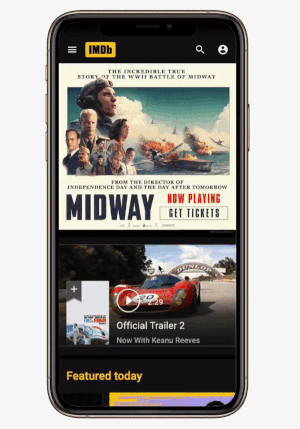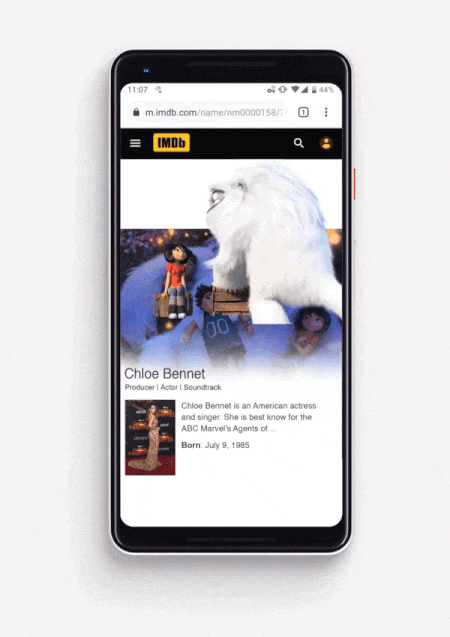
Case Study: Improving the Ad Experience on IMDb
IMDb is classic internet. It’s the number 8 most searched site in the US and one of those sites that you sometimes don’t even know you’re using. It’s a service that is deeply respected by film buffs, celebrities, movie reviewers, cinema goers, trivia aficionados, cord cutters, and so many more. This is a story about how I led an effort to redefine custom advertising across the site to deliver a better user experience for entertainment fans.
The Results of the Project
This is a bit of a read so I'll start off with the results.
Interaction rates of custom ads on IMDb increased 5x over to our traditional ads.
5X
Interaction rates of custom ads on IMDb increased 10x over the legacy iteration of the same product.
10X
After the redesign, custom ads moved inline and became scalable across our mobile breakpoints.
Scalable
Timelines to produce the product were reduced by at least 50%.
50%
The ability to launch more custom executions like games opened up as well.
Games
My Role
Despite the large scale of the site, IMDb as a company is very small with under 200 people on the main site. Designers have to be able to wear multiple hats. “That’s not my job” is not in the lexicon of a designer on my team.
Executed both of the published user studies employing research methodology designed by my Principle Researcher.
Led all client conversations, kick off calls, interviews, and reviews for customer alignment.
Defined site-wide ad slot position on iOS & Android and for all 5 breakpoints on responsive web.
Designed the core user experience of the product templates and defined their production effort.
Built all prototypes and motion mocks for internal and external alignment as well as for use in user testing.
Project managed, designed, and executed all Beta tests.
Defined all ad spec and design guardrails for product launch.
Developed and published all design documentation, pitch decks, and training materials.
The Prior Design
Prior to this redesign, you might see an experience like this one, one of our most popular display ads. These are called Premium Title Pages (PTPs). Many movie studios, including Disney, use these Premium Title Pages on IMDb as their main website destination driving hundreds of millions of users from all over the internet. To them, the Premium Title Page on IMDb is the front page of their movie.
To movie studios, the Premium Title Page on IMDb is the front page of their movie.
The Challenge
The only way to view the exclusive videos, gallery images, interviews, and more was to click on a button that would take you to a “landing page”. These landing pages carried very poor interaction rates due to the hidden nature of the content within. Users were not able to reap the benefits of the exclusive content provided by movie studios.
As a product designer at IDMb and a movie lover myself, I had to find a way to make these ads more valuable. The interaction rates on landing pages told me that discoverability might be in question.
User Research
I conducted a moderated qualitative user study with the help of our Principal User Researcher to find out how users interact with the Premium Title Page ad.
Participants reported that the Premium Title Page ad did not enhance their IMDb viewing experience. However, it is to note that almost all participants found value in the exclusive movie content on the landing page. This means that we need to find a solution that pulls out that valuable exclusive content housed in the frustrating landing page and deliver it to the user in a more discoverable, contextual way.
“This seems like an extraneous experience. I dont know why I have to click over to this [landing page] to see the character posters.” - Jane User
Proofing User Value with Business Value
A previous A/B test showed that inline ads were the most successful. If we were to take that same approach and bring our custom units inline, we theoretically would increase interaction rates from the abysmal level they were at in the landing page. This solves the issue of delivering content in a contextual way. But we have a dilemma.
Advertisers and movie studios love the destination section despite its poor UX. For them, it’s the best way for them to show off as much of their movie as they can. Much like the giant cardboard cutouts you see at a movie theater, digital ads for movies also need to be big and in your face. Our advertisers only wanted to occupy as many pixels as possible. So I needed to convince them that bringing content out of the destination section would do just that.
So, My PM and I traveled to London, a smaller market for IMDb where we test a lot of our betas, to meet directly with Movie Studios. After discussing the results of the initial user study with Netflix, Lionsgate, and Sony, we were able to convince them to ditch the landing page and scatter their valuable exclusive content throughout their IMDb page in a more contextual manner. There would be more eyes on the ad due to its improved discoverability.
Defining Success
Before we can jump into the design we needed to define a couple success metrics first.
Interaction rates of inline units need to be higher than the site average for ads.
We must launch across all platforms (Android iOS, mobile web) simultaneously.
We cannot create any new tech; we must use the tech already implemented across the site (innovate within the box).
We have to focus on mobile.
MVP needs to house all content from the legacy landing page.
Starting the Design Process
I designed a POC by prototyping a series of dynamic ad slots throughout the title page to simulate the reflow of all of the custom content from the landing page.
I worked with tech teams across the company to help define guard rails and limits to the tech that could be implemented within each inline ad slot. I’d approach them with my prototype and walk through how they would build it in a production environment. The result of these discussions was a series of three inline slots that would live across all platforms. Each slot is positioned on the page such that the user will never see two ads at once. In general, each ad is always at least one and a half phone screen lengths apart.
Once again, with the help of our principal researcher, I tested the prototypes in a remote unmoderated qualitative study. This study was designed to understand general perception of inline custom advertising on IMDb.
Users reacted positively to the presence of inline custom advertising. Most notably, ads that are contextual and relevant. Other results that we found in study included the removal of gratuitous animation, no auto-play video, and no auto-play audio.
Here is one of the prototypes I created for the study.
Inspiring Designers
I turned to Photoshop and After Effects and started mocking up examples to show how creative my designers could be using these new inline ad slots. For this experience, it was appropriate to jump right into high fidelity creative mocks. I really needed to get designers inspired about what could be accomplished given the guidelines I had received from my tech teams. One of the main teams that would use this new product would be my creative production design team. This was meant to illustrate to these designers how my proposed UX will make their designs even better.
Scaling for Production
Much like the guard rails that my tech teams put on me, I needed to put some guard rails on the production design team. That way we can form a more unified design language that we can measure and learn from. To accommodate the numerous requests by our clients, I defined a series of design templates. By templatizing the design, we can guarantee a reduced production timeline from the original 20 days down to a possible 10 days. We can remove the requirement of QA from static units and allow designers to completely bypass developers by building tools for them to build and launch their own units.
Measuring the Design
We launched a series of betas to test how the new design would compare against the traditional landing page as well as how it would perform against all ads on IMDb.
We partnered with Amazon Studios for the upcoming release of The Marvelous Mrs. Maisel, and agreed to give them a free inline premium product in the hopes that we could test and learn from the execution to know if we were on the right track with our approach to the UX.
Thanks in part to the initial research studies, our hypothesis was proven correct in this beta. Delivering custom ad content inline in a relevant and contextual way allowed for an average of a 5x increase in engagement with our users compared to our traditional ads. A whopping 10x increase next to our previous landing pages engagement rates. The simplified approach to the templates that I designed reduced the production timeline of Premium Title Pages from 20 days to 10 days. An unexpected result was that the specific implementation of using inline ad slots allowed us to lazy load content. This opened up the possibility to build custom games as well.
Follow-through
I trained IMDb’s global internal production and development teams to deliver top-quality designs that obey the specs defined by our tech teams so that every Premium Title Page that launches does so within the bounds of possibility and in a timely, bug free manner. I did this by running numerous trainings and presentations as well as equipping them with proper PSD and Json templates to aid in their design process.
Launch
Once all the betas have run and you’re finished evangelizing the product for lunch, you get this gem of an email from your PM. And it's golden. All of the testing, learning, listening, interviewing, arguing, sweating, sighing, designing, redesigning, rendering, coding, bug-bashing, apologizing, begging, thanking, drinking, and all other verbs are finished, you can launch the product.
So, We’re Done, Right?
Yup, let's go grab a beer and marvel at our success. Just kidding. We still have a lot of work to do. I’ll take the beer though if you don’t want it.
Now we get to keep measuring, testing, and learning and iterating. I know I can make it even better and user needs change like the seasons. A designer's work is never done… and that's the best part.





